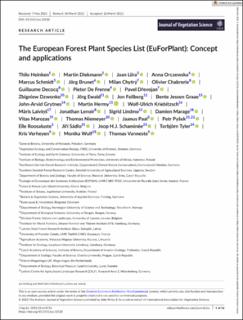The European Forest Plant Species List (EuForPlant): Concept and applications
| dc.contributor.author | Heinken, Thilo | |
| dc.contributor.author | Diekmann, Martin | |
| dc.contributor.author | Liira, Jaan | |
| dc.contributor.author | Orczewska, Anna | |
| dc.contributor.author | Schmidt, Marcus | |
| dc.contributor.author | Brunet, Jörg | |
| dc.contributor.author | Chytrý, Milan | |
| dc.contributor.author | Chabrerie, Olivier | |
| dc.contributor.author | Decocq, Guillaume | |
| dc.contributor.author | De Frenne, Pieter | |
| dc.contributor.author | Dřevojan, Pavel | |
| dc.contributor.author | Dzwonko, Zbigniew | |
| dc.contributor.author | Ewald, Jörg | |
| dc.contributor.author | Feilberg, Jon | |
| dc.contributor.author | Graae, Bente Jessen | |
| dc.contributor.author | Grytnes, John Arvid | |
| dc.contributor.author | Hermy, Martin | |
| dc.contributor.author | Kriebitzsch, Wolf-Ulrich | |
| dc.contributor.author | Laiviņš, Māris | |
| dc.contributor.author | Lenoir, Jonathan | |
| dc.contributor.author | Lindmo, Sigrid | |
| dc.contributor.author | Marage, Damien | |
| dc.contributor.author | Marozas, Vitas | |
| dc.contributor.author | Niemeyer, Thomas | |
| dc.contributor.author | Paal, Jaanus | |
| dc.contributor.author | Pyšek, Petr | |
| dc.contributor.author | Roosaluste, Elle | |
| dc.contributor.author | Sádlo, Jiří | |
| dc.contributor.author | Schaminée, Joop H.J. | |
| dc.contributor.author | Tyler, Torbjörn | |
| dc.contributor.author | Verheyen, Kris | |
| dc.contributor.author | Wulf, Monika | |
| dc.contributor.author | Vanneste, Thomas | |
| dc.date.accessioned | 2023-02-13T09:51:33Z | |
| dc.date.available | 2023-02-13T09:51:33Z | |
| dc.date.created | 2022-09-22T14:19:39Z | |
| dc.date.issued | 2022 | |
| dc.identifier.citation | Journal of Vegetation Science (JVS). 2022, 33 (3), 1-16. | en_US |
| dc.identifier.issn | 1100-9233 | |
| dc.identifier.uri | https://hdl.handle.net/11250/3050283 | |
| dc.description.abstract | Question When evaluating forests in terms of their biodiversity, distinctiveness and naturalness, the affinity of the constituent species to forests is a crucial parameter. Here we ask to what extent are vascular plant species associated with forests, and does species’ affinity to forests vary between European regions? Location Temperate and boreal forest biome of Northwestern and Central Europe. Methods We compiled EuForPlant, a new extensive list of forest vascular plant species in 24 regions spread across 13 European countries using vegetation databases and expert knowledge. Species were region-specifically classified into four categories reflecting the degree of their affinity to forest habitats: 1.1, species of forest interiors; 1.2, species of forest edges and forest openings; 2.1, species that can be found in forest as well as open vegetation; and 2.2, species that can be found partly in forest, but mainly in open vegetation. An additional “O” category was distinguished, covering species typical for non-forest vegetation. Results EuForPlant comprises 1,726 species, including 1,437 herb-layer species, 159 shrubs, 107 trees, 19 lianas and 4 epiphytic parasites. Across regions, generalist forest species (with 450 and 777 species classified as 2.1 and 2.2, respectively) significantly outnumbered specialist forest species (with 250 and 137 species classified as 1.1 and 1.2, respectively). Even though the degree of shifting between the categories of forest affinity among regions was relatively low (on average, 17.5%), about one-third of the forest species (especially 1.2 and 2.2) swapped categories in at least one of the study regions. Conclusions The proposed list can be used widely in vegetation science and global change ecology related to forest biodiversity and community dynamics. Shifting of forest affinity among regions emphasizes the importance of a continental-scale forest plant species list with regional specificity. | en_US |
| dc.language.iso | eng | en_US |
| dc.publisher | Wiley | en_US |
| dc.rights | Navngivelse-Ikkekommersiell 4.0 Internasjonal | * |
| dc.rights.uri | http://creativecommons.org/licenses/by-nc/4.0/deed.no | * |
| dc.title | The European Forest Plant Species List (EuForPlant): Concept and applications | en_US |
| dc.title.alternative | The European Forest Plant Species List (EuForPlant): Concept and applications | en_US |
| dc.type | Peer reviewed | en_US |
| dc.type | Journal article | en_US |
| dc.description.version | publishedVersion | en_US |
| dc.source.pagenumber | 1-16 | en_US |
| dc.source.volume | 33 | en_US |
| dc.source.journal | Journal of Vegetation Science (JVS) | en_US |
| dc.source.issue | 3 | en_US |
| dc.identifier.doi | 10.1111/jvs.13132 | |
| dc.identifier.cristin | 2054412 | |
| cristin.ispublished | true | |
| cristin.fulltext | original | |
| cristin.qualitycode | 1 |
Tilhørende fil(er)
Denne innførselen finnes i følgende samling(er)
-
Institutt for biologi [2516]
-
Publikasjoner fra CRIStin - NTNU [37304]

